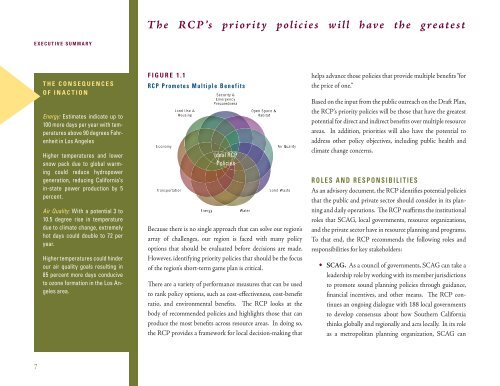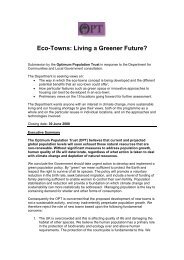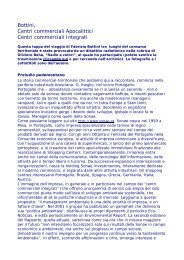Constrained Policies
Constrained Policies
Constrained Policies
You also want an ePaper? Increase the reach of your titles
YUMPU automatically turns print PDFs into web optimized ePapers that Google loves.
The RCP’s priority policies will have the greatestEXECUTIVE SUMMARYTHE CONSEQUENCESOF INACTIONEnergy: Estimates indicate up to100 more days per year with temperaturesabove 90 degrees Fahrenheitin Los AngelesHigher temperatures and lowersnow pack due to global warmingcould reduce hydropowergeneration, reducing California’sin-state power production by 5percent.Air Quality: With a potential 3 to10.5 degree rise in temperaturedue to climate change, extremelyhot days could double to 72 peryear.Higher temperatures could hinderour air quality goals resulting in85 percent more days conduciveto ozone formation in the Los Angelesarea.FIGURE 1.1RCP Promotes Multiple BenefitsEconomyTransportationLand Use &HousingEnergySecurity &EmergencyPreparednessIdeal RCP<strong>Policies</strong>WaterOpen Space &HabitatAir QualitySolid WasteBecause there is no single approach that can solve our region’sarray of challenges, our region is faced with many policyoptions that should be evaluated before decisions are made.However, identifying priority policies that should be the focusof the region’s short-term game plan is critical.There are a variety of performance measures that can be usedto rank policy options, such as cost-effectiveness, cost-benefitratio, and environmental benefits. The RCP looks at thebody of recommended policies and highlights those that canproduce the most benefits across resource areas. In doing so,the RCP provides a framework for local decision-making thathelps advance those policies that provide multiple benefits “forthe price of one.”Based on the input from the public outreach on the Draft Plan,the RCP’s priority policies will be those that have the greatestpotential for direct and indirect benefits over multiple resourceareas. In addition, priorities will also have the potential toaddress other policy objectives, including public health andclimate change concerns.ROLES AND RESPONSIBILITIESAs an advisory document, the RCP identifies potential policiesthat the public and private sector should consider in its planningand daily operations. The RCP reaffirms the institutionalroles that SCAG, local governments, resource organizations,and the private sector have in resource planning and programs.To that end, the RCP recommends the following roles andresponsibilities for key stakeholders: SCAG. As a council of governments, SCAG can take aleadership role by working with its member jurisdictionsto promote sound planning policies through guidance,financial incentives, and other means. The RCP continuesan ongoing dialogue with 188 local governmentsto develop consensus about how Southern Californiathinks globally and regionally and acts locally. In its roleas a metropolitan planning organization, SCAG can7










